How Many Autoflowers Can I Grow In A Square Meter?
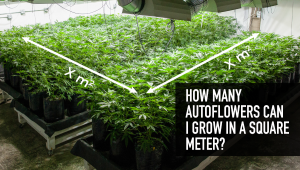
- 1. What determines plant size in nature?
- 2. What determines plant size indoors?
- 2. a. Genetics
- 2. b. Pot size
- 2. c. Lights
- 2. d. Training
- 3. How to calculate the area of my growing space
- 4. Calculate number of plants based on pot size
- 5. Calculate light potency based on the number of plants
- 5. a. Leds
- 5. b. Light bulbs
- 6. How can plant training help me in these situations?
- 6. a. The tie-down method
- 6. b. Sea of green (sog)
- 7. In conclusion
There are several things that help control the size of an autoflower, things like genetics, lights, and pot size make it possible to grow up to 6 plants per 1 square meter. Almost all cannabis consumers that want to start cultivating their own cannabis want to fulfill their needs without having to spend too much. To do that, you have to make the most out of your grow space.
There are a number of things that can help you achieve that without having to spend more in another grow setup.
1. What Determines Plant Size In Nature?
When growing in nature, there’s nothing to limit a plant's size. As they’re not growing in closed space, cannabis grown outdoors can grow even more than 3 m tall. That, of course, doesn’t apply to indoor growers. Indoor growers have a limited amount of space, lights, nutrients, and medium. This can be seen as a bad thing, but this also gives us the ability to have complete control of our plant, being able to determine how tall, bushy, and even how much buds it will produce. To do that, we adjust the type of light and size of the pot, we can also apply plant training and pruning to adapt the cannabis to what we have available.
Sure, the environment plays a fundamental role when it comes to plant size. You can take two seeds of the same giant Sativa strain and experience two very different outcomes. If you were to place one seed directly in the ground outdoors in a sunny position, it would easily fulfill its genetic potential and become a towering and productive specimen. Place the other seed into a 10L pot, place it into a grow tent, and provide it with only 8 hours of light all day, and the same strain would grow to be much smaller and less productive. Environment aside, genetics also play a key role. This factor dictates how each subtype of cannabis will grow on the even playing field of nature. Large Sativa plants are almost tree-like in size and shape. In contrast, Indica-dominant specimens are naturally shorter and bushier. Then we have autoflowering plants. Because they contain Ruderalis genetics, they are the smallest strains available. They’ll only grow to a certain size, even when provided with unlimited space. This makes them ideal when growing in small spaces or looking to keep your growing operation as stealthy as possible.
2. What Determines Plant Size Indoors?
There are a couple of main factors that will determine the size our plant will grow. All of them can be adjusted to fit your preferences and can be adjusted according to your grow space and genetics you’re growing, and can dictate how much cannabis can yield per square meter.
Genetics
As you may know, Sativas grow tall and thin and Indicas grow short and bushy. This is one of the main factors that will affect how your plant grows. Even though nowadays it’s hard to find a pure Sativa or Indica, the hybrids most growers cultivate is a mix of pure Indica and Sativa genetics, and depending on the hybrid (it can be Sativa or Indica-dominant) it will grow shorter or taller. A great example of a hybrid strain is our Orange Sherbet Auto which grows tall and bushy, showing characteristics of both Indica and Sativa lineage.
When calculating how many square meter per autoflower you need, this is the first thing we should have in mind, a Sativa-dominant hybrid can grow more than 2 m (6.5 ft) tall if no training is applied, while an Indica hybrid can reach up to 1.4 m (4.5 ft) tall. So, if you’re looking to grow Sativa-dominant strains, you won’t be able to fit as much in your grow tent as if you were growing Indica-dominant cannabis. You also need to take into account whether you will be growing autos or photoperiod cannabis plants. But what exactly is the difference? Well, to begin with, auto-flowering plants carry the ruderalis genes alongside either Sativa or Indica. Cannabis Ruderalis is a species of cannabis that hails from the Asian steppes, Siberia, Russia, and eastern Europe. Pure ruderalis have very low counts of THC and other cannabinoids, rarely grow larger than about 2 feet, have thin and weak plant structure, and produce low amounts of bud. Not usually what growers are looking for, to say the least.
But Cannabis Ruderalis has one saving grace. Normal photoperiod plants can be forced to stay in the vegetative growth stage through the control of the light cycle. As long as you keep the lights on for 18+ hours per day, a photoperiod plant will never go into flower. But with Ruderalis, there is an inbuilt timer that will automatically switch the plant into the flowering growth stage no matter what the light schedule. When experimentation with the Ruderalis species began the results were a little disappointing, to say the least. But, in the last 2 decades thanks to the hard work and dedication of growers and seed banks, Ruderalis has been successfully crossed with regular weed. Autoflowering plants now come in a wide range of strains and strengths and can hold their own with even the most awarded photoperiod plants. But why would someone choose to grow autos over regular plants? Well, that’s pretty simple:
- They take much less time and have a much faster lifecycle, with the entire grow taking the same or sometimes less time than just the flowering stage for photoperiod plants.
- They make discreet cannabis cultivation easy since they usually stay under about 1.2 meters in height.
- Since they flower under any lighting conditions (even 24 hours), it makes setting up a perpetual harvest routine much simpler. You can have plants at any stage of their lifecycle in the same grow area without having to worry about how they will be affected.
- Ruderalis genes are extremely resilient. They usually offer better natural protection from pest, bacterial, and mold infestations than photoperiods.
- They deal with light pollution issues much better than photoperiod plants. Have you ever tried to grow a photoperiod plant outdoors only to realize that the streetlights are causing flowering issues, or maybe you have had some indoor plants turn hermie thanks to light leaks? Not an issue with autos whatsoever.
- They require lower doses of feed nutrients, meaning a lower overall cost for the crop.
They do come with a few small downsides though, spending on how you like to grow:
- They can not handle HST (High-Stress Training) techniques for the most part. Techniques like topping or fimming put a large strain on the plant, and they need time to recover from HST. Autos don’t really have that extra time to recover, since they will switch to flowering growth after a set period no matter what you do with them.
- Smaller plants equal smaller yields. This can be easily offset by planting a couple more plants, but it is something to keep in mind. These days the difference really isn't so huge, with autos offering hygge yields when grown correctly.
- No way to grow from clones. Autos must be cultivated from seed, as any clones will stick to the flowering timing of the mother plant, meaning there is simply not enough time for the plant to develop before flowering begins.
- Autoflowering cannabis plants are perfect for novice growers and offer an easy growing experience that can yield huge rewards.
Pot Size
Pot size is another very important factor. The amount the roots grow underneath will reflect directly in the size of your plant, so if you grow in a 5 L pot your plant will be smaller than if you grow in a 10 L pot. Even if there’s a difference in the size of Sativa and Indica-dominant strains, pot size will decrease their overall size, as they won’t have space for the roots to grow. The size of the above-ground aerial part of a cannabis plant is a reflection of what’s going on beneath the soil. Outdoors, plants have plenty of space to spread out their roots, which results in bigger plants. Indoors, and in small pots, plants are much more limited. The roots grow outwards and downwards until they make contact with the side of the container. From here, they begin to spiral and grow more chaotically, continually looking for any spare space to grow into. Eventually, they develop a ball-like structure and become rootbound.
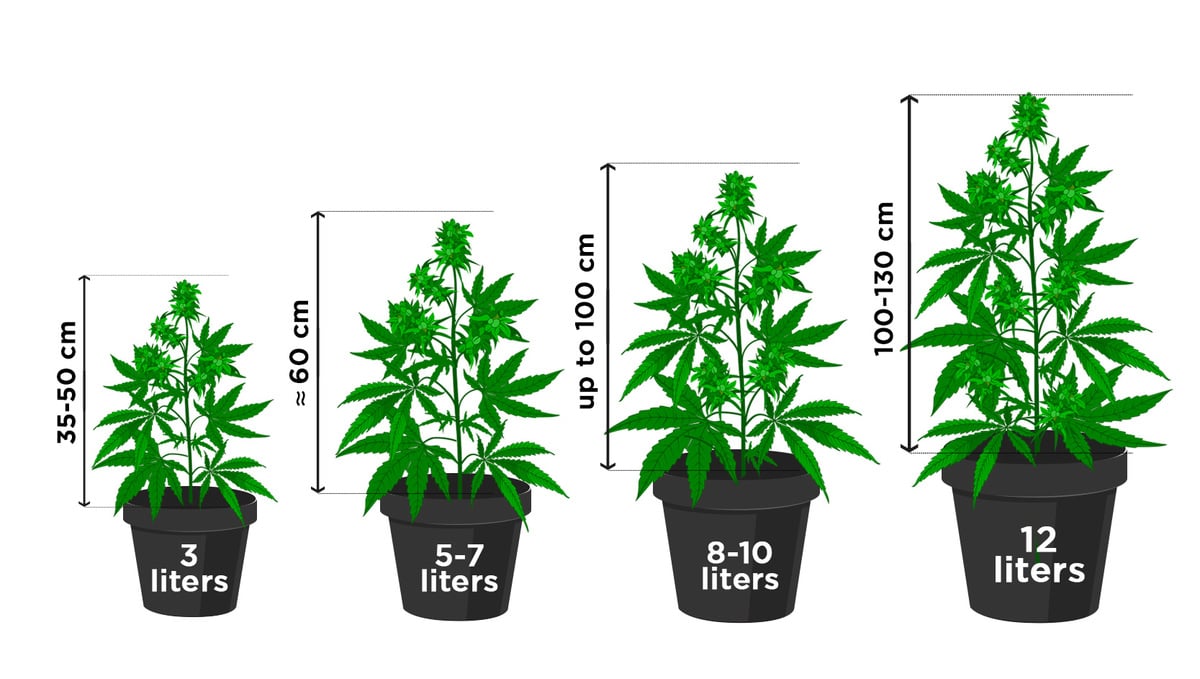
For autoflowers, we recommend not going too big when choosing the pot size. Usually, an autoflower in an 11 L pot will grow to its full height, as where an autoflower in a 5 L pot will grow of medium height and in a 3 L will grow small. If you don’t have space issues, we recommend going with 11-12 L pots so your plants can develop to their fullest. You might be tempted to select a much bigger pot size. That will result in a large and more productive plant, right? Not quite. Sure, your plant will grow slightly larger, but small autos quickly hit their limit. An overly sized pot can cause water to pool at the bottom of the container, resulting in anaerobic conditions that breed pathogenic anaerobic bacteria that can cause root rot. Remember, autos hate being stressed or strained.
Any major stress can force a plant to reduce its growth rates for up to a week, and autos just don't have that sort of time to play with. So, we always recommend starting the plants in the pots you want to finish them in. This is due to the fact that even if you are supremely careful, transplanting weed plants causes the plant to experience high levels of stress. There is no way to keep every single root from snapping, and you will inevitably hurt the final yield if you transplant autos.
Lights
Light coverage and intensity will also influence, not only the size but also the amount of resin and density of buds. When you grow too many plants in a small space, some will throw shade over others and the ones left underneath will not be able to develop properly. That’s why you need to know the size of your grow space before buying the grow lights, this will ensure you get good coverage that can satisfy all your cannabis.
Training
There are numerous plant training techniques, even though the methods vary, all of them have the same goal: adjust your plant to the growing space. For autoflowers we recommend using low stress training (LST) techniques or using the Sea of Green (SOG) method to make the most out of your grow room.
3. How To Calculate The Area Of My Growing Space
Calculating the area of your space is fairly simple. To do this, we need a measuring tape to measure the length and width of our growing space. If we are planning to grow in a grow tent, we can find this information in the manual, but if it isn’t available, it is fairly simple to measure it. So for example, if after measuring the length of our growing space is 1 m (3.2 ft) and the width is 1 m, we multiply both to get the total area, so: 1x1 = 1 square meter(10.2 ft). This applies to any size, even if our growing space is not a perfect square. Another example is: length = 2 (6.5 ft) and width = 3 (9.8 ft), we would have an area of 2 x 3 = 6 square meter (64.5 ft2).
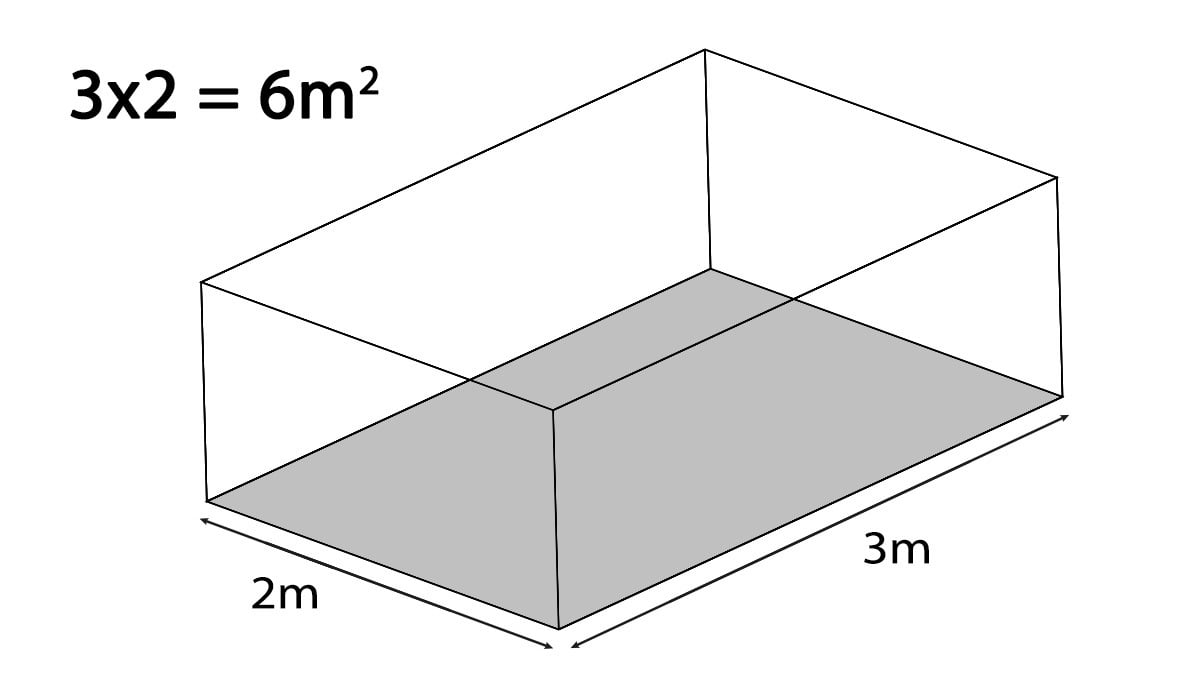
This is extremely helpful because based on the area of our growing space we can calculate the potency of the light we will need and the plants we can fit in it. If you’re measuring in cm, divide the result by 100 to have the area size in m2. For example: 200 x 400 = 800 cm2, 800 cm2 ÷ 100 = 8 square meter.
Follow the same logic to obtain the area in square feet.
4. Calculate Number Of Plants Based On Pot Size
For these examples, we will use a space of 1 square meter but you can do the math with your space’s measurements and you will have the same result. Calculating exactly how many plants we can fit in our space or how many square meter per autoflower you need can be difficult, this is a general guide and may vary depending on your growing environment. Pots come in different shapes and sizes, and depending on the size, you will be able to fit several in your grow space. There’s no general rule but depending on the size of the pot you choose, you will limit the size of your roots, which will have a direct impact on the plant’s size.
Usually, we use the following table as a guide:
| Pot Size | Number Of Plants Per m2 | Plant Size |
|---|---|---|
| 3 L (0.6 gal) | 25 | 25 cm (9.8 in) |
| 5 L (1.3 gal) | 18 | 60 cm (23.6 in) |
| 11 L (2.9 gal) | 9 | Full plant height |
| 15 L (3.9 gal) | 5 | Full plant height |
| 18 L (4.7 gal) | 2 | Full plant height |
| 21 L (5.5 gal) | 1 | Full plant height |
We can calculate the number of plants by multiplying the plants by the area of our growing space. So let’s say, our space has a width of 2 m (6.5 ft) and a length of 3 m (9.8 ft), (2 x 3 = 6) the area of our growing space would be 6 square meter (64.5 ft2).
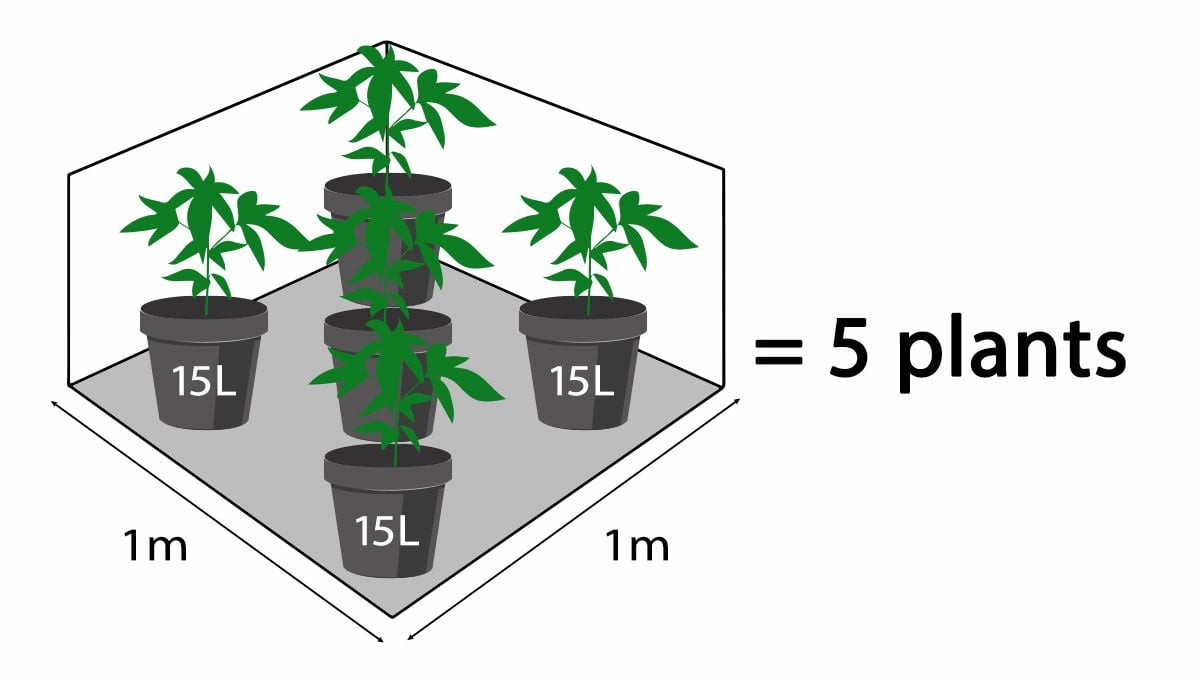
So, based on the table, we can have 5 plants in 15 L pots in 1 m2, so we multiply the number of plants by the area: 5 plants x 6 square meter = 30 plants. This means we can fit 30 plants in 15 L pots in 6 square meter (64.5 ft2). You can adjust this to any size of space just by looking at the table and doing basic math.
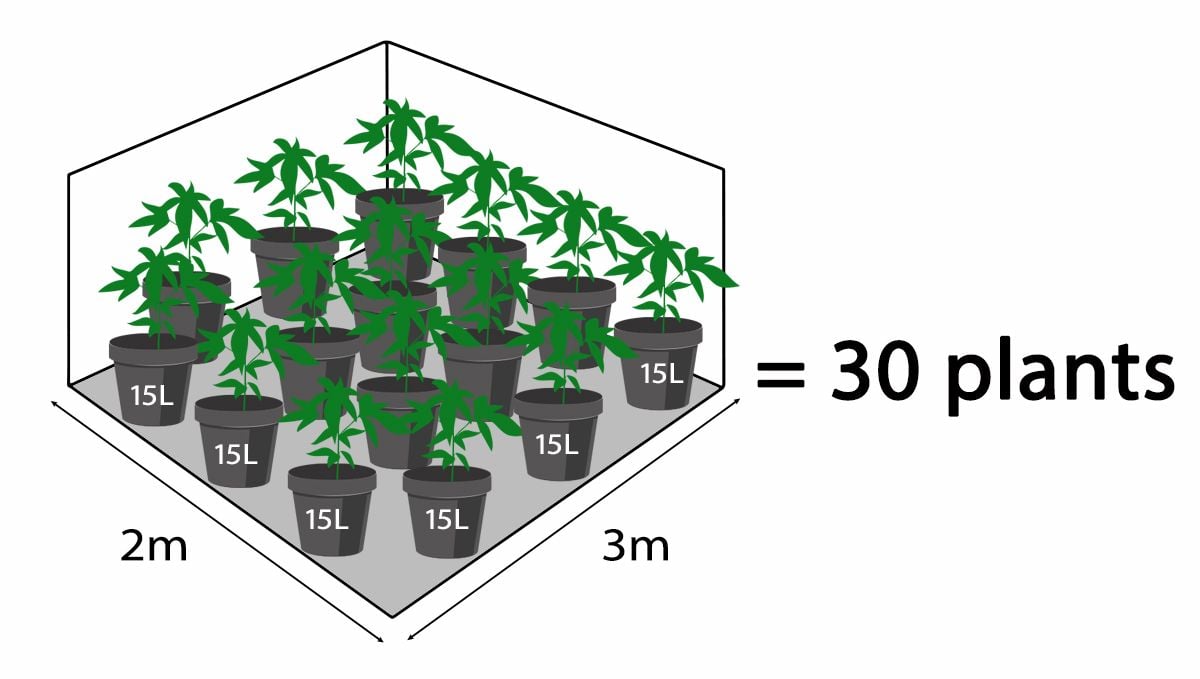
If you really want to fit more cannabis in your grow space, we recommend using rectangular pots, this will prevent you from wasting space.
Follow the same logic to obtain the number of plants for square feet.
Keep in mind that the last thing that cannabis plants like is to be cramped. There is a tendency for new growers to want to fit as many plants as possible into their grow area, and this makes perfect sense to the uninitiated. Why go to all the effort and cost that is involved in setting up a grow room and then not capitalize on every last square inch? This is actually the wrong way to think about it. In general, cannabis plants will thrive when they have just that little extra bit of space. Cramped grow tents and rooms are breeding grounds for fungal, bacterial, and pest issues. Air movement in the canopy is key in combating these issues, so keep that in mind when choosing how many plants to have in the grow space.
5. Calculate Light Potency Based On The Number Of Plants
There are two types of light fixtures: Light bulbs and LEDs.
LEDs
With LEDs it’s impossible to calculate because the quality of the individual LEDs changes from one manufacturer to another. The best thing is to follow the recommendations of the manufacturer that should be in the manual of the light fixture, if not, we recommend sending them an email asking for the information If you tried everything and cannot find the information you need, you can follow the general rule: a 250 W LED is equal to a 400 W light bulb. As said before, this is not always true and is only to be followed if you can’t find any other information about the LEDs you’re buying (almost all decent LEDs provide the area coverage and you shouldn’t worry too much about this).
Even though it’s not recommended because every LED is different if you still want to use this guide for LEDs, you will have to divide the number of watts by 1.6. So if you were to need 2500 W of light bulbs, in LED it would be 2500 W ÷ 1.6 = 1562 W of LED
Light Bulbs
Now, with light bulbs this is different and there indeed is a way to calculate the wattage you will need for your plants, this way you are not calculating how many square meter per autoflower you need but how much light you need. Let’s continue with the example we were following before. We have a space area of 6 square meter (64.5 ft2) and we already know we can fit 30 plants in it, what’s the wattage we will need.
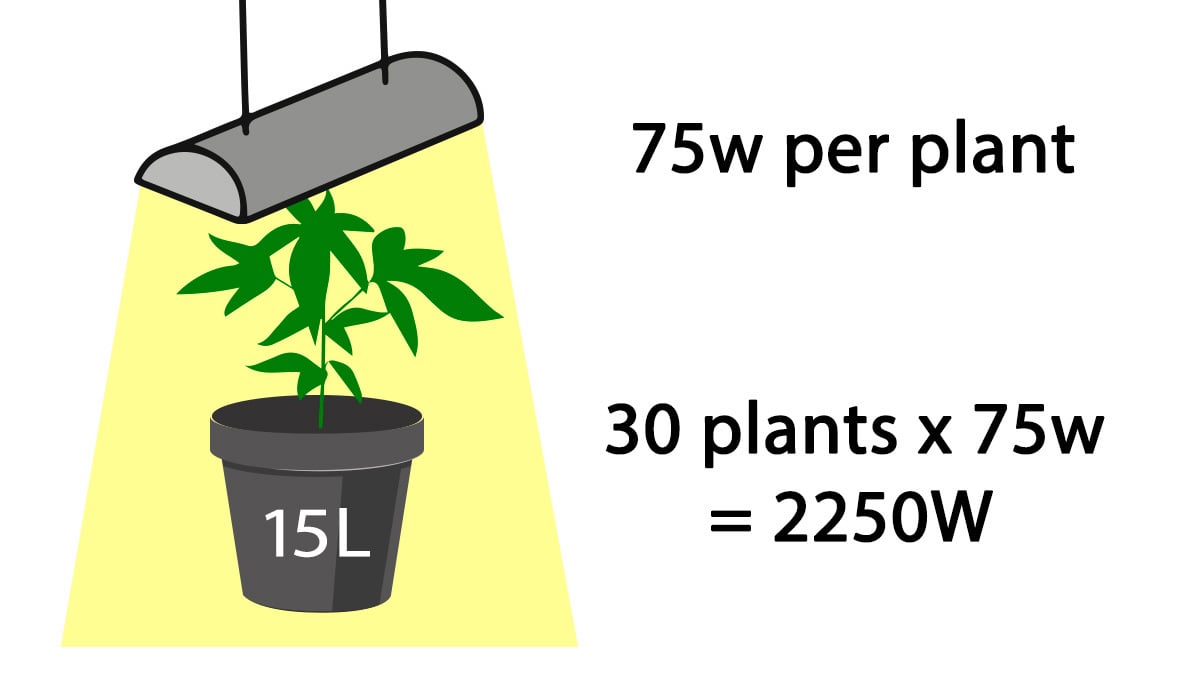
Usually, you would need around 75 W per plant, so by following the table we can calculate how many watts we would need for 30 plants in a 6 square meter (64.5 ft2) space.
| Wattage | Number Of Plants |
|---|---|
| 150 W | 2 |
| 250 W | 3 big or 4 small |
| 400 W | 5 |
| 600 W | 8 |
| 1000 W | 13 big or 14 small |
If you’re growing less than 14 plants, you can just look it up on the table. If you’re growing more like in the previous example, you need to multiply the number of plants by 75 W. So in our example, it would be 30 x 75 w = 2250 W. This means we would need 2250 W to grow 30 plants on 15 L pots in a 6 square meter (64.5 ft2) growing space.
6. How Can Plant Training Help Me In These Situations?
Even though there are a lot of plant training techniques, there are only a few that can be done on autoflowers without any problems. They are the Tie-Down method and the Sea of Green.
The Tie-Down Method
With this technique, you will help the branches open up, allowing light to reach deeper resulting in multiple bud sites and denser buds. By doing this, you will be able to fit fewer plants in your grow space but you will get a bigger yield. Continuing our example, if we had 6 square meter (64.5 ft2) of growing space, we would be able to fit 30 plants. If you applied this method, that would be lowered to around 15 plants, depending on the pot size. You can follow the table for a general guide:
| Pot Size | Plant Number Per m2 |
|---|---|
| 3 L (0.6 gal) | 9 |
| 5 L (1.3 gal) | 6 |
| 11 L (2.9 gal) | 3 |
| 15 L (3.9 gal) | 2 |
In our example, we were using 15 L pots so according to the table, we need to multiply the area by the number of plants, so it would be 6 x 2 = 12. This means we could fit 12 plants in a 6 square meter (64.5 ft2) area when applying the tie-down method. To calculate the wattage needed for those 12 plants, we have to multiply the number of plants by 75 W, so 12 x 75 W = 900 w
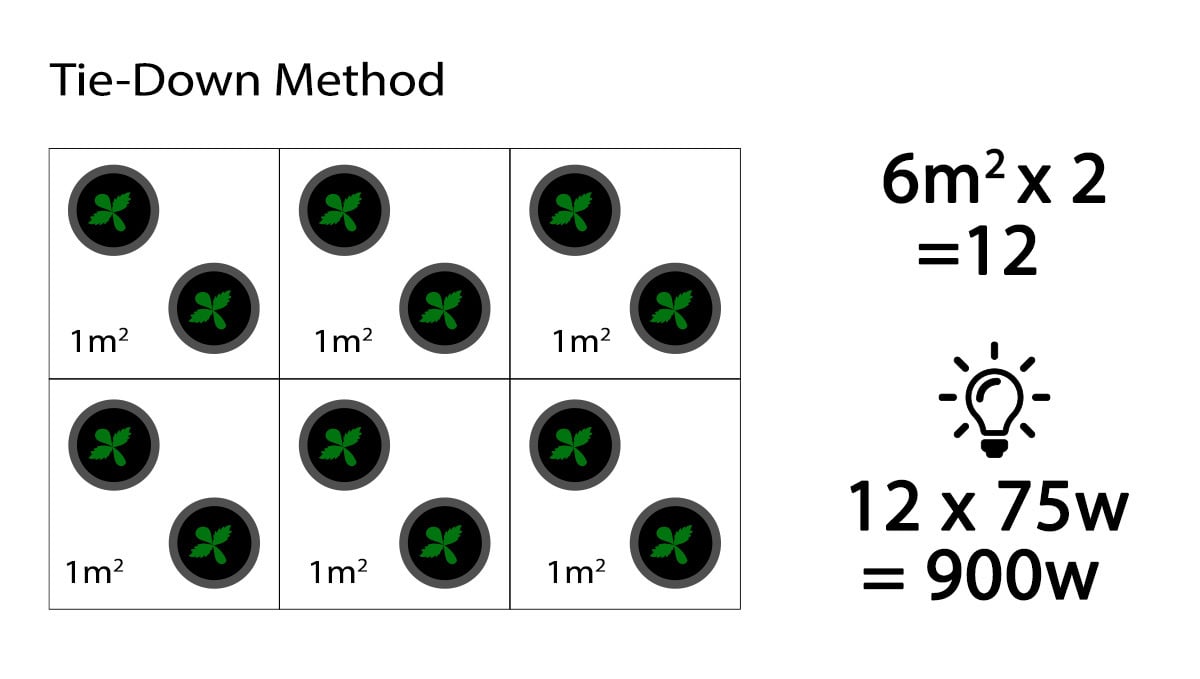
Tip: If you need 900 W and don’t have the space to have one 400 W light bulb + two 250 W light bulbs, you can use a 1000 W bulb. This will not damage your cannabis and will only make them grow more vigorously. Obviously, this is approximate and you can fit a little bit more or less, depending on your skills and need.
Sea Of Green (SOG)
When growing in a Sea of Green, the number is higher than in the Tie-Down method and also higher than growing the plant without any kind of training. This is because plant training methods aim to control a plant's size while also yielding as much as possible. This method consists of slowly training your cannabis into an even canopy, allowing light to reach all bud sites equally. The following is a general guide, and as said before, you can have more or fewer plants depending on your skills and need.
| Pot Size | Plant Number Per m2 |
|---|---|
| 3 L (0.6 gal) | 16 |
| 5 L (1.3 gal) | 11 |
| 11 L (2.9 gal) | 8 |
| 15 L (3.9 gal) | 6 |
So, to recapitulate we had an area of 6 square meter (64.5 ft2) where we would fit 30 plants (without training) in 15 L pots that would need 2250 W of lights. In our example, we are growing in 15 L pots so to calculate how many plants we can fit in a 6 square meter area of SOG, we have to multiply the area size by the plants per square meter in 15 L pots, resulting in 6x6 = 36 plants.
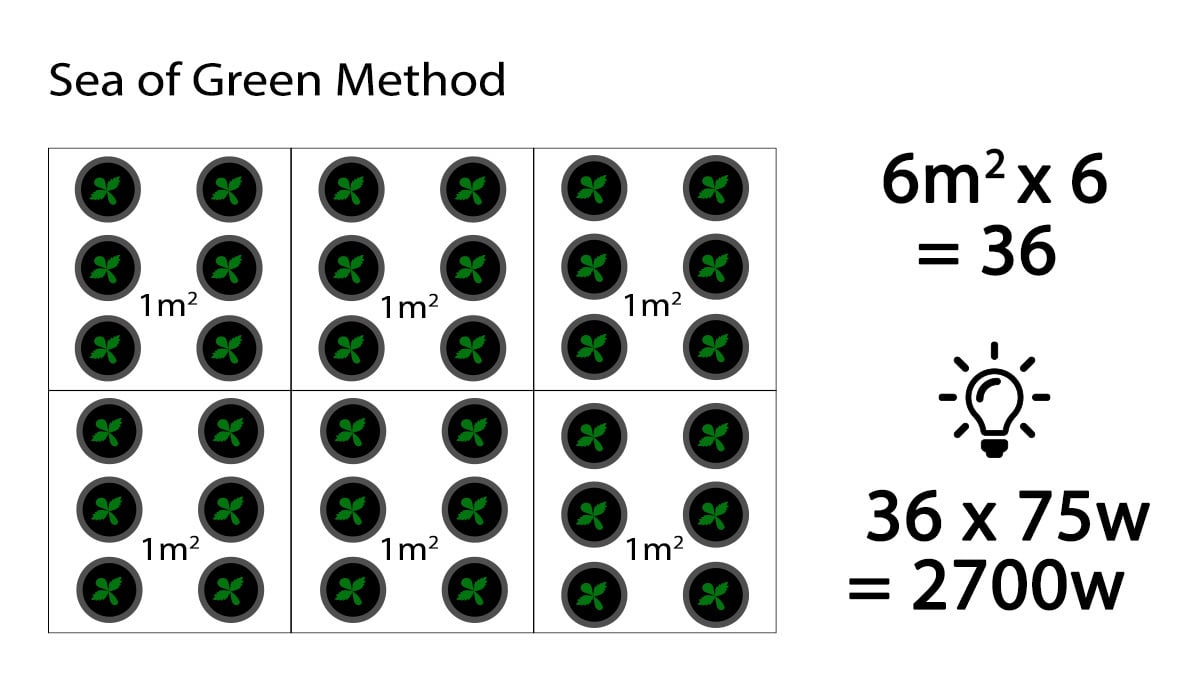
Meaning, we can fit 36 plants in a Sea of Green of 6 square meter, and to calculate the wattage, we have to multiply the number of plants by 75 W, so 36 x 75 w = 2700 W.
7. In Conclusion
The square meter per autoflower will depend on several things, there’s no exact number of plants you can fit in your grow tent, independent of the size. What will truly define that is a combination of your budget, genetics, equipment, and environment; So if you were wondering how many autoflowers per square meter to grow or how much an autoflower can yield per square meter, it can be quite complicated but doing the math will give you an idea.
Remember that everything explained in this article will depend on growing conditions, genetics and how well you take care of your plants; As mentioned, you may be able to fit more (or less) autos per square meter depending on the plant training techniques you perform. Also, it's very important to have in mind that some cannabis may grow tall despite being in smaller pots and others will not grow too much even if they're growing in bigger pots so as you finish each grow cycle you will have a better idea of not only how that specific strain grows but also what it needs and what you have to provide for it to thrive.
Have in mind that all cannabis plants are different and they will grow according to the environment they're in, so even if it's the same strain, growing it outdoors and indoors will result in slightly different (or completely different) growth which can be seen in how much your plants stretch, yields, aromas and effect so if you want are planning on cloning a certain plant, make sure you grow it in similar conditions, either outdoors or indoors.
If you are looking for plants to grow in smaller pots and haven’t decided what to grow in your next cycle yet, we recommend our Zkittlez Auto and Gorilla Cookies Auto. Both of them grow between 40-100 cm (15.7-39 in) and will develop well with LST techniques.
If you are looking to grow fewer plants but bigger, we recommend our Orange Sherbet Auto and Wedding Cheesecake Auto, these ladies grow 150 and 130 cm (59 in and 51 in) respectively and will grow tall and yield quite a lot when cultivated in bigger pots. And remember, taking good care of your cannabis will result in beautiful frosty flowers, it doesn’t matter if they’re big or small.
When growing outdoors you can control the growing conditions to a certain extent but when growing indoors you're in full control of the environment, from nutrients to lighting so it's vital that you can not only adjust but also maintain the conditions so that you keep getting consistent results and remember that this is just a guide so there can be tiny differences in the plants you can fit and light your cannabis need according to the elements mentioned throughout the article. This guide will help novice growers figure it out, but it’s all a matter of preference.








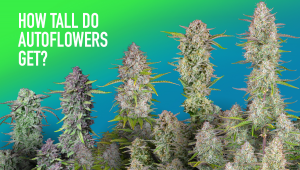
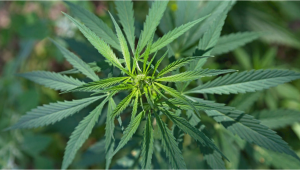
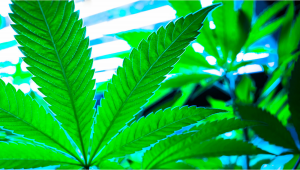
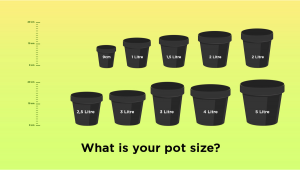

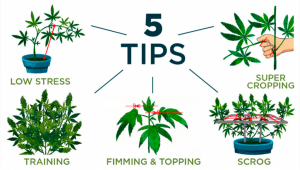

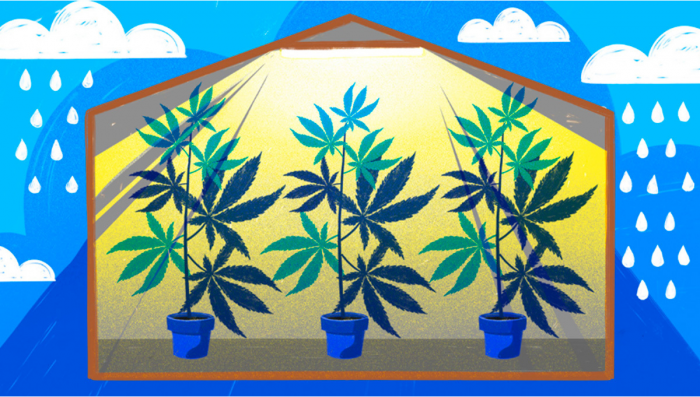
Comments